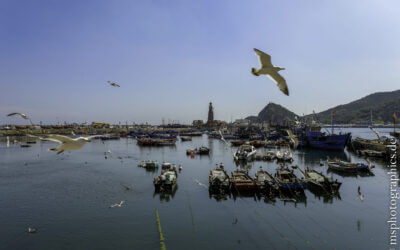City trip Spain by train – travel planning:
After a two-days stay, we traveled by train from Barcelona via Granada and Córdoba to Seville.
The Spanish Railways offers special passes for city breaks, which can be used to combine multiple journeys on different types of trains. This makes a trip pleasant and less expensive.
Arrival in Barcelona:
I booked the Barceló Sants hotel for the duration of my stay. It is practically integrated into the train station and is particularly suitable for train travelers. But the accommodation can also be easily reached from the airport by subway.
The somehow futuristic-looking accommodation is based on a space station and you will find small, hidden details on the subject of space everywhere.
The included breakfast buffet is rich, fresh and delicious.
The view from the hotel at sunset. Despite the central location, right next to the train station, the rooms are pleasantly quiet.
The Hospital de la Santa Creu i Sant Pau:
The Hospital de la Santa Creu i Sant Pau, which has been a UNESCO World Heritage Site since 1997, is just one of Barcelona's many attractions. The hospital with its 48 independent pavilions was built in two phases, from 1902-1911 and from 1912-1939.
The colorfully decorated buildings are integrated into a magnificent, large garden. Since 2009, the complex is no longer used as a hospital.
A walk through the garden of the former hospital is a real treat. Chairs and benches invite you to linger and relax. A visit should not be missed when you are in Barcelona.
Walking through Barcelona:
Despite the well-developed subway network, it is still worth exploring the city on foot. If you walk from the Hospital de la Santa Creu i Sant Pau along the boulevards of Barcelona, you will pass the Casa de les Punxes.
This fascinating building was constructed in 1905 and has been open to the public again since 2017.
Casa Milà:
The Casa Milà is one of the buildings of Barcelona's most famous architect, Antonio Gaudí. The house was built from 1906-1912. Casa Milà has been part of the UNESCO World Heritage since 1983.
Parts of the building are now used as offices or are still inhabited. In the other rooms there are exhibitions that can be visited.
The typical features of the architect Gaudí can be found throughout the building. The idiosyncratic shapes, asymmetrical lines and ornaments on the chimneys are just examples.
Casa Batlló:
Not far from Casa Milà is Casa Batlló, another work by Antonio Gaudí. The house was built in 1877 and remodeled in 1904-1906. The building has been a listed building since 1962 and was declared a UNESCO World Heritage Site in 2005. The Casa Batlló is another example of Gaudí's idiosyncratic but fascinating and detailed architectural style.
Through the old town to the beach:
The Platja de Sant Miquel, one of Barcelona's city beaches, is a great place to end the day and enjoy the sunset before returning to the accommodation.
The Park Güell:
Like Casa Milà and Casa Batlló, Park Güell is another project of Antonio Gaudí. It was built from 1900-1914. The site was left in its natural state and the buildings were integrated into the hilly landscape accordingly.
The park has been part of the UNESCO World Heritage since 1984.
On an area of about 17 hectares, you can go for a pleasant walk and discover the countless details of Antonio Gaudí's buildings.
The Park Güell is my personal highlight in Barcelona, due to its location and the unique landscape.
The Sagrada Família:
If the distances in Barcelona are too long and strenuous to walk, you can also easily reach the sights by subway or on a city tour by bus.
Conclusion:
Barcelona is not only one of the largest cities in Europe, but also has a lot to offer culturally and architecturally. The buildings by Antonio Gaudí in particular characterize the cityscape and are among the most important sights of the metropolis.
For some of the popular buildings and sights, tickets are limited due to the high number of visitors and it is important to make reservations in advance.
If you are interested in unusual architecture and Mediterranean flair, you will certainly not be disappointed in Barcelona. Two days isn't much, but it's just enough to explore the most important sights of the Catalonian capital.















































0 Comments